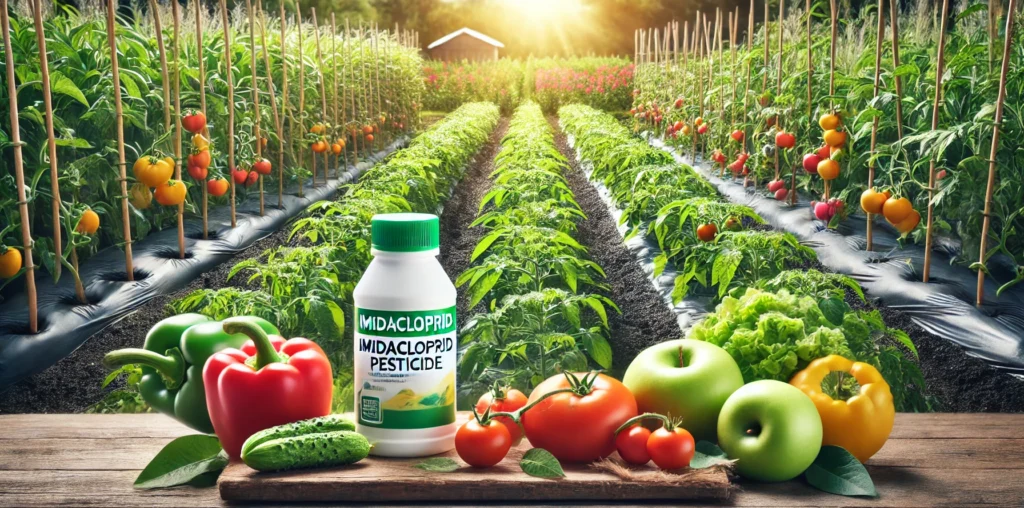Pollination is a critical agricultural process, directly impacting fruit and vegetable yields. Many farmers rely on thiamethoxam insecticide to protect their crops from damaging pests. Still, concerns have been raised about its potential effects on pollinators such as bees, butterflies, and other beneficial insects. Since pollination is essential for the reproduction of many crops, understanding the relationship between thiamethoxam and pollination rates is crucial for both productivity and sustainability.
Thiamethoxam, a neonicotinoid insecticide, is known for its systemic properties, meaning it is absorbed into plant tissues and provides long-lasting pest control. However, this same characteristic raises questions about its potential effects on pollinators that come into contact with treated plants. Farmers must balance pest control effectiveness with pollinator safety to ensure stable crop production with increasing regulatory scrutiny on neonicotinoids worldwide.
The Role of Pollinators in Fruit and Vegetable Production
Pollinators play a fundamental role in agriculture by transferring pollen from one flower to another, facilitating fertilization. Over 75% of global food crops, including essential fruits and vegetables such as tomatoes, cucumbers, apples, and berries, depend to some extent on pollinators. These crops experience lower yields, deformities, and reduced quality without adequate pollination.
The main pollinators in agricultural landscapes include:
- Honeybees: The most common pollinators, essential for large-scale fruit and vegetable production.
- Bumblebees: Highly efficient in greenhouse and cold-weather pollination.
- Butterflies and moths: Important for certain crops, especially in diverse ecosystems.
- Beetles and flies: Less common but contribute to pollination in some fruit crops.
If thiamethoxam interferes with pollinator activity, farmers may experience reduced fruit set, leading to lower overall harvests.
How Thiamethoxam Works and Its Potential Risks to Pollinators
Thiamethoxam disrupts pests’ nervous system, leading to paralysis and death. It is available in various formulations, including:
- thiamethoxam 70 ws – A seed treatment that protects young plants from early pest infestations.
- thiamethoxam 70 wg – A water-dispersible granule applied as a foliar or soil treatment to control a broad spectrum of insects.
- thiamethoxam 70 – A term encompassing multiple formulations used for different crop protection strategies.
While these formulations effectively target crop-damaging pests, research indicates that neonicotinoids can be detected in plant nectar and pollen, potentially exposing pollinators to harmful doses. Studies suggest that sublethal exposure to thiamethoxam can lead to:
- Disorientation: Bees may have trouble returning to their hives, reducing colony efficiency.
- Weakened immunity: Increased susceptibility to diseases and parasites like the Varroa mite.
- Reduced foraging activity: Lowered efficiency in pollen collection, impacting pollination rates.
However, the degree of risk depends on application methods, dosage, and environmental conditions. Proper management practices can help mitigate these risks while still benefiting from the pest control effectiveness of Texan PW – Thiamethoxam 70% WS systemic insecticide, which is widely used to protect crops from early pest damage.
Balancing Pest Control and Pollinator Health
Farmers must maximize yield protection while ensuring pollinators remain active in their fields. The good news is that strategic application methods and integrated pest management (IPM) practices can reduce negative impacts.
Best Practices for Using Thiamethoxam While Protecting Pollinators
- Apply treatments outside of bloom periods: Avoid spraying when flowers are open and actively attracting pollinators.
- Use seed treatments instead of foliar sprays: thiamethoxam 70 ws is less likely to expose pollinators than foliar applications.
- Adopt targeted spraying methods: Precision application can limit off-target exposure and reduce the risk to beneficial insects.
According to agricultural studies, using alternative pest control strategies alongside thiamethoxam can reduce the impact on pollinators by up to 50%. This highlights the importance of integrating biological controls, crop rotation, and habitat preservation.
“Sustainable farming is not just about protecting crops; it’s about protecting the ecosystems that support them.”
Regulatory Landscape: The Future of Thiamethoxam in Agriculture
Due to concerns about pollinator health, regulatory bodies worldwide have implemented restrictions on certain neonicotinoids, including thiamethoxam. The European Union has banned outdoor use of neonicotinoids in an effort to protect pollinators, while other countries, such as Canada and the U.S., have imposed usage limits.
Global agricultural policy updates provide essential information on approved applications and best practices for farmers who want to stay updated on pesticide regulations.
Despite these challenges, thiamethoxam remains widely used due to its effectiveness in pest control. Some companies are working on developing modified formulations with reduced pollinator toxicity, ensuring future compliance with regulations while maintaining its benefits in agriculture.
Economic Considerations: Does Thiamethoxam Impact Crop Yield Value?
For many fruit and vegetable growers, the thiamethoxam 70 ws price is a key consideration in pest management decisions. While synthetic insecticides provide cost-effective solutions for pest control, declining pollination rates can result in financial losses due to lower yields.
Farmers must weigh the economic trade-offs:
- Short-term gains: Thiamethoxam reduces pest-related losses, preventing crop damage.
- Long-term risks: Lower fruit and vegetable yields can lead to revenue losses if pollination rates drop.
Studies indicate that pollination contributes 30-50% of fruit production value, meaning farmers must adopt strategies that balance insecticide use with pollinator conservation.
For more insights into pesticide pricing trends and economic impacts, resources like global market trends in pesticide use can help farmers make informed decisions.
Frequently Asked Questions
Is thiamethoxam safe for all crops?
Yes, but application guidelines vary by crop. Always check regulations before use.
How does thiamethoxam compare to older insecticides?
It offers longer residual protection with lower application frequency but requires careful management to protect pollinators.
Can pollinator-friendly alternatives replace thiamethoxam?
Some bio-insecticides and natural predators provide alternatives, but they may not be as effective against certain pests.
Does thiamethoxam directly kill bees?
Not in most cases, but sublethal doses can affect behavior and colony health, leading to reduced pollination efficiency.
Moving Forward: Finding a Balance Between Protection and Productivity
Thiamethoxam and pollinators have a complicated connection. It is impossible to overlook this insecticide’s possible impacts on bees and other pollinators, even if it is still a very effective weapon for controlling pests. Farmers can make sure they maintain their crops and the vital pollinators that support agricultural ecosystems by implementing more intelligent application methods, including alternative pest management measures, and keeping up with regulatory changes.
Future crop protection will be greatly influenced by continuing research into sustainable farming methods and insecticides that are favorable to pollinators. Farmers will be in a better position to sustain good yields and promote a thriving, healthy environment if they adjust to these changes.



